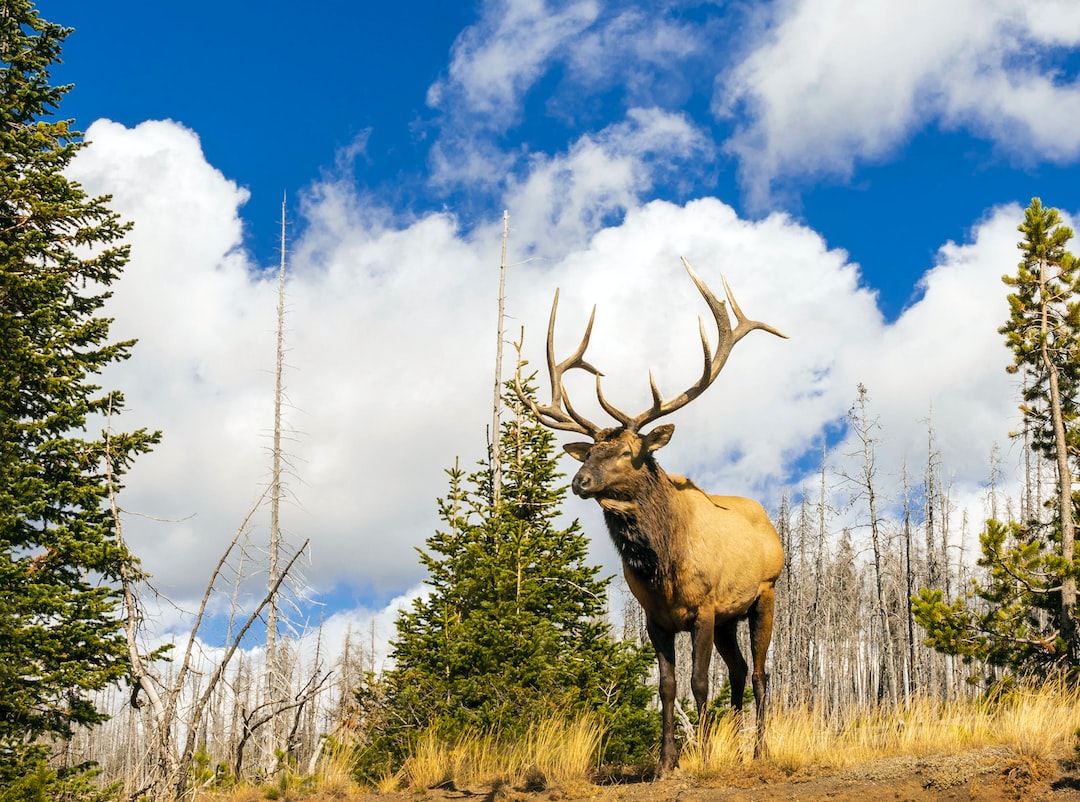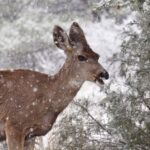If you’re an outdoors enthusiast, then you’ve likely heard of elk wallows.
But do you know what a wallow is and how elk use them? Wallows are important to understand if you want to increase your success rate while hunting for elk.
In this article, we’ll explore the basics of what a wallow is, how elk use them in their environment, where they can usually be found and finally some strategies and gear necessary when hunting with these special areas in mind. Let’s get started.
What is a Wallow?
A wallow is a shallow depression in the ground that is usually filled with mud or water.
It is created by animals, such as elk, to keep cool and ward off parasites during hot summer months. They are also used to mark territory and assert dominance among other animals.
Wallows can vary in size from small puddles to large ponds and may be used for both bathing and socializing.
Types of Wallows:
There are two main types of wallows: drywallows and wetwallows.
Drywallows are typically found on higher ground where there is little moisture available; they consist of dirt mixed with urine, saliva, or other bodily fluids that have been deposited by an animal in order to create a damp area for cooling down.
Wetwallows are more common on lower-lying areas where there’s more access to water; these tend to be larger than drywallows and often contain standing water due to their proximity to rivers or creeks.
A wallow is a shallow depression in the ground that serves as an important resource for elk, providing them with protection and access to food. By understanding how elk use wallows, hunters can gain valuable insight into their behavior patterns and increase their chances of success on the hunt.
How Elk Use Wallows
Elk are a majestic species of North American wildlife, and their utilization of wallows is essential to their life cycle.
Wallows provide elk with a variety of benefits that make them an essential part of the animal’s life cycle. Understanding how elk use wallows can help hunters better understand these creatures and develop strategies for hunting them successfully.
Wallows serve as natural mud baths for elk, providing a way to cool off during hot summer months. The mud also helps protect against pests like ticks and other parasites that could otherwise harm the animal’s health.
Additionally, wallowing is thought to be used by male elks as a way to attract mates during mating season. By rolling around in the mud, males create pheromones which can alert female elks nearby that they are ready to mate.
When scouting or hunting near a wallow, keep an eye out for several sets of tracks leading in and out of the same area where muddy water has pooled. This could be indicative that multiple animals are taking advantage of its cooling effects on hot days or protection from predators like bears and wolves prowling nearby seeking easy prey items such as deer or moose calves.
You may also witness bull elks jousting around the vicinity – another sign they’re utilizing it during mating season when bulls battle each other for access rights (September-October). Be sure to take note of these key signs so you can better understand how elk use wallows.
It is essential for hunters to understand how elk utilize wallows as they are a vital component of the ecosystem and offer numerous advantages. Now let’s take a look at where these wallows can be found in order to locate potential hunting spots.
Where are Wallows Usually Found?
Wallows are depressions in the ground that elk use for a variety of purposes, including cooling off and rubbing against vegetation.
Wallows are usually situated near bodies of water, such as streams and ponds, with plenty of shade and good soil drainage. Wallows tend to be situated in shady spots with good drainage, so water does not pool nearby. Ideal locations for wallows include meadows, riverbanks, and other open spaces where elk feel safe from predators.
Signs of an active wallow include flattened grasses or mud scraped away from the depression itself. Elk also leave tracks leading into and out of the wallow as well as signs of their presence such as droppings or antlers shed during rutting season.
If you’re lucky enough to find a recently used wallow then it’s likely that there will still be wet mud inside it which is another indication that it is being actively used by elk herds nearby. If the water is clear on top, it has probably been a few days since recent activity. If the water is chopped up and murky, activity could have been within hours.
Strategies for locating wallows involve scouting ahead before hunting season begins to identify potential spots where elk may congregate due to their proximity to food sources like grassy fields or riparian zones along riversides.
It is also helpful to look at topographical maps since these often show existing water sources near meadows which could indicate ideal locations for finding a wallow site. Additionally, keeping an eye out for fresh tracks while on your scouting trips can help you pinpoint active sites even further away from any potential food sources – something especially useful if you are looking to target trophy bulls far away from populated areas.
Plentiful water and lush greenery, such as in marshy meadows or along riverbeds, are typical spots for wallows to be found. With this knowledge, hunters can begin to look for signs that an elk wallow is nearby and strategize on how best to approach the area when hunting season arrives. Next we will discuss strategies for hunting elk near a wallow.
Hunting Strategies for Elk and Wallows
Preseason Scouting Tips:
Preseason scouting is essential for successful elk hunting. It’s important to look for wallows and other signs of elk activity, such as rubs and droppings. Look for tracks around the edges of wallows that indicate frequent use by elk.
Pay attention to wind direction when scouting; it can be beneficial to set up stands near a wallow so you’re downwind from where the animals are likely to come in. Think about installing game cameras close to wallows for insight into their usage and the hours when they’re most active.
Seasonal Tactics for Hunting Near a Wallow:
During the early season, bulls tend to stay away from heavily trafficked areas like wallows due their desire for solitude during this period; however, if there is enough water available in your area then these spots can still be productive hunting locations during this time frame.
Later on in the season when bulls become more social, these places become ideal locations because multiple individuals may gather together at one spot making them easier targets than those spread out across large distances throughout the woods or mountainside.
Setting up stands or blinds near a well-used wallow can be advantageous because you’ll have better visibility over a larger area than if you were just standing out in open terrain without any cover or concealment nearby.
By employing the tactics outlined in this article, you can be sure to have a successful hunt for elk and wallows. Equipping yourself with the correct items is essential to increasing your likelihood of a successful elk and wallow hunt.
Gear Necessary for Hunting Elk and Using Wallows
When hunting elk and using wallows, the right gear is essential for success. Clothing that helps you blend into the environment while also providing warmth and protection from outside conditions is essential for a successful elk hunt.
Optimal clothing includes a camouflage patterned jacket or vest, insulated pants, waterproof boots, gloves, hat and face mask. Footwear should have good traction to prevent slipping on wet ground or mud near a wallow.
Outfitted with the proper gear, an experienced hunter can increase their chances of success when hunting elk and using wallows. Camouflage clothing should be chosen to blend in with the environment while providing warmth and protection from adverse weather conditions; waterproof boots are a must for traversing wet ground or mud near a wallow.
Binoculars, spotting scopes, rangefinders, rifles or bows that are accurate over long distances, scent-eliminating sprays and soaps to keep you undetected by wary game animals – all key components of your arsenal. In addition to these items, backpacks designed specifically for hunters will come in handy along with maps showing topography as well as access points such as roads or trails.
You may also want to consider decoys used to lure animals into view; calls that mimic animal sounds which attract them closer; trail cameras set up at wallows monitoring activity levels during different times of day/year – further enhancing your prospects.
Don’t forget to pack essentials such as torches, bug spray, fire starters and medical kits for a successful elk hunt. Being prepared with all the necessary gear before heading out into the field after elk can greatly increase your chances of success, even when hunting wallows.
FAQs in Relation to Elk Wallows
Why do elk use wallows?
Elk use wallows to cool off and protect themselves from biting insects. Wallowing is a behavior where elk roll in mud or shallow pools of water, creating depressions in the ground. The mud helps them stay cool during hot summer days and provides protection against pesky bugs like mosquitoes.
Additionally, wallowing can help remove parasites from their fur and skin as well as prevent hair loss due to overheating. Wallowing also serves an important social purpose for elk; they often gather together at wallows to interact with one another while cooling off.
What time of day do elk hit wallows?
Elk typically hit wallows in the early morning and late evening hours. This is when they are most active, as the cooler temperatures allow them to conserve energy during these times. During midday, elk tend to rest in shaded areas or move up into higher elevations where it’s cooler.
Wallowing behavior usually occurs at dawn and dusk; however, depending on location and weather conditions, elk may also be seen using wallows throughout the day.
How often do elk use wallows?
Elk use wallows on a regular basis, particularly during the summer months. Wallowing helps elk stay cool and rid themselves of parasites such as ticks and flies. They will often roll in mud or dust to coat their skin with these materials, which can act as natural insect repellents.
During the fall rutting season, bulls also use wallows to attract cows by releasing pheromones from glands located near their eyes that are mixed with dirt when they rub against them while rolling around in the wallow.
Where can I find elk wallows?
Elk wallows are typically found at the start of a natural springs. Over time, these areas become dug out and a depression in the ground forms after many years of rolling and thrashing around.
They can be found near water sources, particularly during mating season when bulls use them to attract cows. Wallows can be found in areas with trails, food sources, and other animals as well.
Look for signs of trampled vegetation or soil disturbance indicative of an elk wallow. Additionally, keep an eye out for the presence of other elk as wallows are often frequented by multiple animals.
Conclusion
In conclusion, elk wallows are an important part of the hunting experience and should be taken into account when planning a hunt. Wallows provide valuable information about where to look for elk, as well as giving hunters insight on their behavior and habits.
Knowing how to find them and what strategies work best can help make any hunt more successful. Having the right equipment is essential when hunting in areas with wallows, to ensure an optimal experience.



